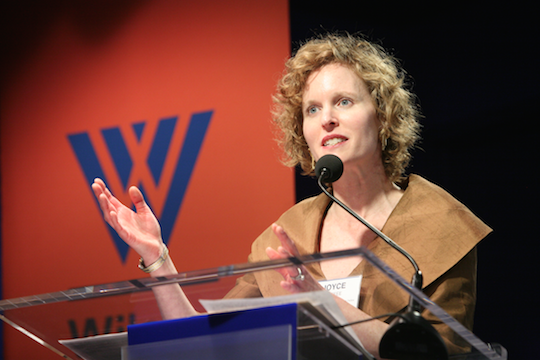
Joyce Coffee, Notre Dame Global Adaptation Index Managing Director, opens last year’s ND-GAIN Annual Meeting.
Recent data indicate that a gap exists between corporations understanding the big-picture risks of climate change and their actions to address those risks to shore up their bottom line.
MIT’s Sloan Management Review published results of the annual sustainability survey they conduct withBCG (aka The Boston Consulting Group). In Harvard Business Review‘s synthesis, they note: “The vast majority of respondents in a new Sloan and BCG survey say climate change isn’t a significant issue … And of the 27 percent that acknowledge climate change is a risk to their businesses, only 9 percent say their companies are prepared for the risk.”
In contrast to this data, another corporate survey—the annual World Economic Forum Global Risk Report–says, this year, four out of the top 10 global risks derived from the World Economic Forum’s global risk perception survey relate to climate disruption:
- Water Crisis
- Failure of Climate Change Mitigation and Adaptation
- Greater Incidence of Extreme Weather Events
- Food Crisis
These risks share space with other risks such as high unemployment, fiscal crisis and political and social instability.
As the report starts: “To manage global risks effectively and build resilience to their impacts, better efforts are needed to understand, measure and foresee the evolution of interdependencies between risks, supplementing traditional risk-management tools with new concepts designed for uncertain environments.”
The takeaway from WEF’s report: It’s up to all of us to build and refine the proper measurement tools to ensure we are creating business opportunities that offer rewards for humanity in this era of climate risk. A goal will be to pair other notable trends about sustainability progress to lead the way.
So, based on the WEF numbers, if corporations see a risk, but, based on the MIT numbers, they do nothing about it, that gap suggests that businesses are not yet sure how to manage the risk that a changing climate brings to their value chains.
Since climate adaptation relates to the direct impacts on our most important assets—our employees, our customers, our communities and our families–those who advise corporations possess a great opportunity to demonstrate to their clients the significant collateral benefits of a five-step plan of adaptation action. The five steps are outlined briefly here, and will be rolled out in-depth throughout a six-part, biweekly series on Triple Pundit.
- Examine the relative risks of geographies in supply chains. Where are your most vulnerable communities and supply chains? What resilience can be built to protect these people and assets?
- Identify relevant vulnerabilities in geographies where you maintain significant human and capital assets. Tools like ND Global Adaptation Index can help, plotting countries on a matrix and digging into specific country profiles. When assessing their global risks, corporate leaders can also employ other indices to inform their thinking—from Transparency International’s Corruption Perception Index, to the major credit-rating agencies’ foreign-currency ratings, and the World Economic Forum’s Global Competitiveness Report.
- Review your business-continuity plans based upon these vulnerabilities and risks, perhaps including an economic risk analysis for the most likely issues. If you are just beginning this assessment, draft up a list of questions based on research surrounding steps one and two. Use this information to inform your business-continuity plan.
- List strategies that could be used to prepare your most vulnerable assets. What investment is available and what processes must be taken to secure these assets?
- Create a short and medium-term plan that does three things: 1) Starts with adaptive actions you already are taking as part of your business as usual. 2) Sets priorities of adaptations with collateral benefits; e.g., mitigating greenhouse gas emissions (onsite stormwater management), improving employee morale (work from home options) or buoying your reputation (shoring up public health systems in one of your supplier hubs). 3) And, very importantly, includes financials for avoided risks.
Many cities, including Toronto, New York and London publish their adaptation plans, and they are worth a look for inspiration.
Stay tuned for the second post in this series, which will publish next week on TriplePundit.
Joyce Coffee is managing director of the Notre Dame Global Adaptation Index (ND-GAIN). Coffee, who is based in Chicago, serves as the executive lead for related resiliency research, outreach and execution. Stay tuned for the next post in “The Climate Adaptation Gap” series on Tuesday, May 20. The series will deep-dive into the complicated look at supply chain risk assessment. Next up: “Relative Risks of Geographies in Supply Chains”.